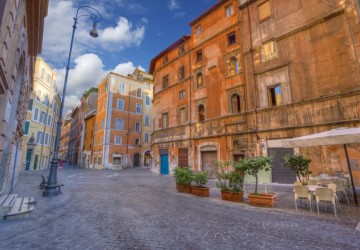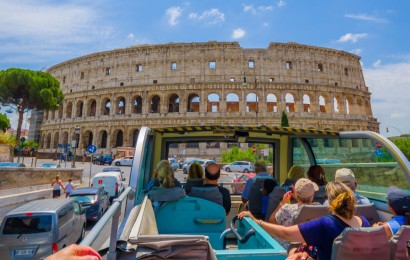The street food of the Ghetto of Rome is to be tried at least once during a trip to Rome. The Jewish Ghetto is located on the left bank of the Tiber, between Largo Argentina, one of the oldest sanctuaries in Rome and the Tiber Island. You can visit it with our Hop On Hop Off, reaching the stop 5 of Piazza Venezia, where you can first visit the Teatro Marcello and the Capitol.
The Jewish Quarter has retained its character to this day, despite its central location in the heart of Rome. Here, you can find archaeological, cultural and religious evidence and try the true kosher cuisine in the city.
Here are some tips to live this experience to the fullest.
Casherut and the consumption of kosher food
The Casherut (or Kasherut) indicates the suitability of a food to be consumed by the Jewish population according to the norms established in the Torah, interpreted by exegesis in the Talmud and codified in the Shulchan Arukh.
The Torah and the Pentateuch classify the animals allowed by Casherut in groups and also explain how they should be slaughtered. The slaughter, in Hebrew shecità, must be carried out so that all blood is eliminated. Among the quadrupeds it is allowed to eat those that have the split hoof and the divided nail, and that are ruminants.
The main rules Kosher
- Jews are strictly forbidden to eat meat and milk together.
The sharp division between meat and milk is in fact the basis of Jewish cuisine. Not only can you mix the two different types of ingredients during cooking, but also not at the table: the meal must be either meat-based or only milk-based. The reason why milk should not be mixed with meat is that the first is a food created to give life, while the second comes from a dead animal; - In order to be defined as kosher, restaurants must possess the Teuda, or the certification of membership in Kashrut and are subject to the supervision of the mashgiach, which carries out both the control of raw materials and all procedures;
- The Torah prescribes very precise rules for the slaughter of land animals and birds: they must be slaughtered by an appropriately trained person (a shochet) who uses a special method of slaughter, the shechita;
- The utensils used for non-kosher foods become non-kosher. However, some of these tools, depending on the material with which they are made, can be made suitable for the preparation of new kosher food by immersion in boiling water or by the application of a blowtorch;
- Meat and fish can be eaten in the same meal, but before moving from one to the other you have to rinse your mouth with a little wine;
- At Easter (Pèsach) it is forbidden to consume any substance leavened by the contact between flour and water, also known as chametz. In fact, yeast represents a violent instinct, something that swells and explodes.
During the Easter, observant Jews can only consume matzah, an unleavened bread that represents poverty and humility.
Getting the Kosher brand requires commitment and strict control. Given the high quality standard, Kosher products are also consumed by people of other religions who see in these products safety and health.
Food from the Ghetto of Rome: what do you eat in kosher cuisine?

Here are some unmissable foods of the Ghetto of Rome:
Carciofo alla giudia, one of the most famous dishes of the Judeo-Roman tradition. The artichokes (artichokes cimaroli or mammola) are fried whole and served to be eaten without discarding anything.
Stracotto, a tasty and tasty recipe perfect as a second course and as a condiment for first courses. It is a very tender beef (walker, bell or cum) that is cooked for several hours in abundant oil and tomato sauce.
Concia di zucchine (zucchini tunning), a simple but incredibly good dish. For the traditional tanning, the fried zucchini is used and served cold, after 24 hours of rest and marinating.
Tortino di indivia e alici (Endive and anchovy pie), proposed both as an appetizer and as a fish main course. The pie is composed of simple and poor ingredients: the escarole or curly endive and fresh anchovies. Once assembled and seasoned with a chopped garlic and parsley, the cake is baked in the oven and served lukewarm.
Torta ricotta e visciole (Ricotta and sour cherry cake), one of the most famous sweets of the Jewish ghetto. It is a base of shortbread filled with cow’s ricotta and sour cherry jam, covered with another layer of shortcrust pastry that will result from the slightly singed appearance.
Filetti di baccalà alla romana (Fillets of cod alla romana), a street food very popular in the ghetto of Rome. It is a fillet of cod battered and fried, which is often taken away to be consumed in the streets of Rome.
Origins of the Jewish Ghetto of Rome
The Jewish Ghetto of Rome is among the oldest ghettos in the world, built by Pope Paul IV in 1555 choosing one of the most dilapidated and unhealthy neighborhoods of the city, and where the Jews are separated from the rest of the population
Here the Jews were subjected to a whole series of rules and prohibitions including:
- obligation to reside within the ghetto
- obligation to wear a distinctive sign of belonging to the Jewish community
- prohibition of any trade except rags and clothes
- prohibition to own real estate
Only in 1870, with the breach of Porta Pia, the Italian Army conquered Rome and the city with all its territory was incorporated into the Kingdom of Italy. In the 19th century, Jews achieved, as in the rest of Europe, full emancipation and equal civil rights. The Jews therefore decided to erect a monumental synagogue, called, the Greater Temple where inside the Jewish Museum of Rome can be visited.
The inhabitants of the Jewish ghetto were subjected to two brutal historical events, the deportation on 16 October 1943 when the Nazis carried out a raid and captured over 1,000 Jews from their homes. The prisoners were loaded onto the wagons of a convoy of cattle wagons to Auschwitz. Of the deportees only 16 survived the extermination.
And the 9 October 1982 attack by a Palestinian commando who fired and threw hand grenades at the crowd of the faithful who were leaving the synagogue. Little Stefano Gaj Tachè, just 2 years old, died and thirty-seven people were seriously injured.

